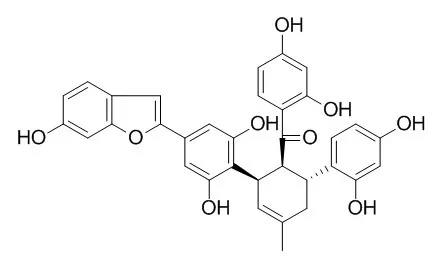| In vitro: |
| Arch Pharm Res. 2015 Nov;38(11):2066-75. | | Isoprenylated flavonoids from the root bark of Morus alba and their hepatoprotective and neuroprotective activities.[Pubmed: 25981820] |
METHODS AND RESULTS:
A new isoprenylated flavonoid, 2S-5,7,2',4'-tetrahydroxy-3',5'-di-(γ,γ-dimethylallyl)flavanone, sanggenol Q (1), along with seven known isoprenylated flavonoids, sanggenol A (2), sanggenol L (3), kuwanon T (4), cyclomorusin (5), sanggenon F (6), sanggenol O (7), and sanggenon N (8), three known Diels-Alder type adducts, sanggenon G (9), mulberrofuran G (10), and Mulberrofuran C (11), and a known benzofuran, moracin E (12), were isolated from the root bark of Morus alba using silica gel, ODS, and Sephadex LH-20 column chromatography. All compounds were evaluated for hepatoprotective activity on t-BHP-induced oxidative stress in HepG2 cells and neuroprotective activity on glutamate-induced cell death in HT22 cells.
CONCLUSIONS:
Compounds 1, 4, 8, 10, and Mulberrofuran C showed protective effects on t-BHP-induced oxidative stress with EC50 values of 6.94 ± 0.38, 30.32 ± 6.82, 23.45 ± 4.72, 15.31 ± 2.21, and 0.41 ± 0.48 μM, respectively, and compounds 1, 2, 10, Mulberrofuran C, and 12 showed protective effects on glutamate-induced cell death with EC50 values of 5.54 ± 0.86, 34.03 ± 7.71, 19.71 ± 0.71, 16.50 ± 7.82, and 1.02 ± 0.13 μM, respectively. | | Biol Pharm Bull. 2016;39(10):1667-1674. | | Anti-HSV Activity of Kuwanon X from Mulberry Leaves with Genes Expression Inhibitory and HSV-1 Induced NF-κB Deactivated Properties.[Pubmed: 27725444 ] |
METHODS AND RESULTS:
Six stilbene derivatives isolated from Mulberry leaves including Kuwanon X, Mulberrofuran C, Mulberrofuran G, Moracin C, Moracin M 3'-O-b-glucopyranoside and Moracin M were found to have antiviral effects against herpes simplex virus type 1 and 2 (HSV-1 and HSV-2) at different potencies except for Mulberrofuran G. Kuwanon X exhibited the greatest activity against HSV-1 15577 and clinical strains and HSV-2 strain 333 with IC50 values of 2.2, 1.5 and 2.5 μg/mL, respectively. Further study revealed that Kuwanon X did not inactivate cell-free HSV-1 particles, but inhibited cellular adsorption and penetration of HSV-1 viral particles. Following viral penetration, Kuwanon X reduced the expression of HSV-1 IE and L genes, and decreased the synthesis of HSV-1 DNA. Furthermore, it was demonstrated that Kuwanon X inhibited the HSV-1-induced nuclear factor (NF)-κB activation through blocking the nuclear translocation and DNA binding of NF-κB.
CONCLUSIONS:
These results suggest that Kuwanon X exerts anti-HSV activity through multiple modes and could be a potential candidate for the therapy of HSV infection. |
|






 Cell. 2018 Jan 11;172(1-2):249-261.e12. doi: 10.1016/j.cell.2017.12.019.IF=36.216(2019)
Cell. 2018 Jan 11;172(1-2):249-261.e12. doi: 10.1016/j.cell.2017.12.019.IF=36.216(2019) Cell Metab. 2020 Mar 3;31(3):534-548.e5. doi: 10.1016/j.cmet.2020.01.002.IF=22.415(2019)
Cell Metab. 2020 Mar 3;31(3):534-548.e5. doi: 10.1016/j.cmet.2020.01.002.IF=22.415(2019) Mol Cell. 2017 Nov 16;68(4):673-685.e6. doi: 10.1016/j.molcel.2017.10.022.IF=14.548(2019)
Mol Cell. 2017 Nov 16;68(4):673-685.e6. doi: 10.1016/j.molcel.2017.10.022.IF=14.548(2019)